Back pain
1. Introduction
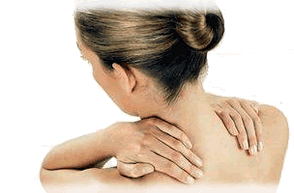
In this article, we present the health promotion campaign for "Back Pain ", divided into 6 easy-to-read chapters, with access to extended information.
This article introduces one of the most widespread ailments: back pain. We also explain how to mitigate and prevent the symptoms when these first appear.
2. Functions of the back
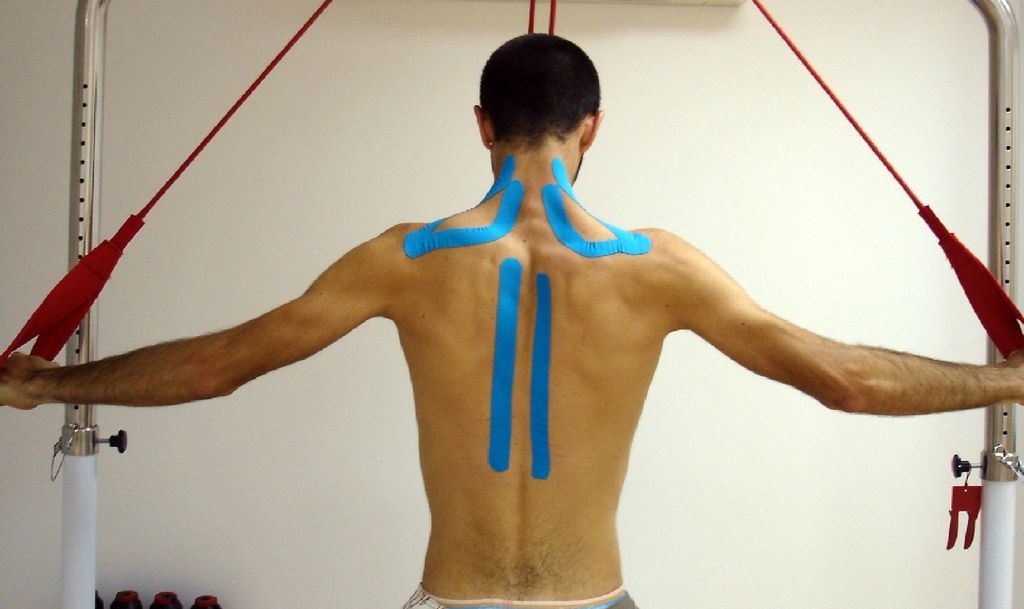
The back has three basic functions:
- Firstly, to support the body and to allow its movement, which is why the back is formed by resistant bones and strong muscles. To allow movement, the vertebral column or spine must be flexible. Therefore, it is not formed by just one big bone but 33 separate vertebrae, arranged one above the other .
- Secondly, tohelp maintain a stable centre of gravity, so the back muscles contract to act as a counterweight that compensates the movements of the rest of the body. To do so, the muscles must be powerful.
- Thirdly, to protect the spinal cord encased in a bony shell.
3. What is our back like?
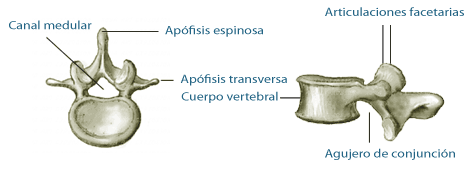
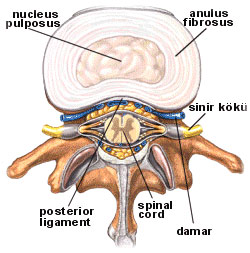
The back is composed of a muscular structure (abdominal, paravertebral, gluteal and hamstring muscles) and a bone structure.
The human spine consists of 33 vertebrae: 7 cervical, 12 thoracic and 5 lumbar, separated by 23 intervertebral disks. The 5 sacral and the 4 coccygeal are fused, forming the sacrum and coccyx bones.
When viewed from the front, the vertebrae are perfectly aligned. However, when viewed from the side, we can see the following anatomical curvatures:
Lordosis cervical curvature concave in the cervical area.
Cifosis dorsal curvature convex to thoracic or dorsal level.
Lordosis lumbar curvature concave in the lower back. This arrangement allows the spine to be very resistant to the load applied verticially, since the curves provide flexibility.
Vertebrae
The vertebrae are the bones that form the spine. They are all articulating bones, positioned one on top of the other. If vertebrae are observed on their own, it can be seen that the front is a cylinder-shaped solid bone, called the vertebral body, which has projections coming out the back that form a central hole where the spinal cord passes through, called the spinal or medullary canal. There are also side projections, called transverse processes, and a rear projection, called the spinous process. In a side view, it can be observed that, positioned one on top of the other, they form holes through which the nerve roots from the spinal cord pass through.
Between the cervical, upper and lower back vertebrae, there is a so-called shock absorber or buffer called the intervertebral disc. It consists of two parts, the central, fleshy, jelly-like core of the disc called the "nucleous pulposus" and a fibrous ring that holds the nucleous in place and is called the "fibrous ring or shell". The nerves do not reach the nucleous pulposus. They only reach the outermost layer of the fibrous ring; this explains why disc degeneration can be painless while it does not affect the outermost layer of the fibrous ring.
With time, the load on the disc causes the nucleous pulposos to wear down due to dehydration and it starts to lose its thickness. This process is known as spinal osteoarthritis; it is not a disease in itself, but most healthy people from age 30 begin to have some degree of wear.
4. Back disorders
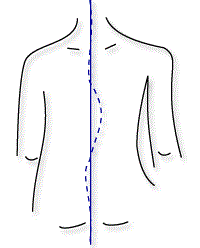
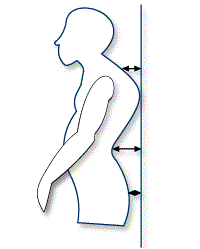
The most frequent disorders are musculoskeletal disorders, for which we have to consider their multifactorial nature.
- Mechanical factors for incorrect foot position: flat feet or claw feet, bow legs or knock knees.
- Individual factors because of the way that each person has for carrying out activities or for wearing inadequate footwear for the activity they are carrying out.
- Factors that condition the individual's responses such as age, obesity, the presence of pain or personality.
- Organisational factors to prevent mental fatigue.
Muscle contracture
Contractures occur when a muscle or a muscle group is subjected to an effort that it is not capable of to or due to a violent or sharp movement; They can also occur as a result of a contraction of one or more muscles maintained over a long period of time without any relaxation of the muscle/s.
A muscle contracture consists of a persistent, involuntary contraction of a muscle. It may be the cause or the consequence of back pain.
Contracture as a cause of back pain:
A contracture occurs when a muscle is required to work harder than what it is capable of, such as making an excessive effort, or when maintaining incorrect postures over several hours.
A muscle contracture acts directly on the nerves responsible for pain and this triggers back pain. Similarly, the contracted muscle can compress the artery and decrease the blood supply. This situation forms a vicious circle whereby the muscle with a lower blood supply tends to contract more easily and also the lack of active blood acts with more intensity on the pain nerves.
If this situation remains over a prolonged period or is repeated frequently, the muscle will contract more easily each time; in this situation, it is necessary to practice suitable physical exercise to break the trend.
Muscle contracture as a consequence of back pain:
Irrespective of the reason, back pain itself can cause a muscle contracture due to a reflex mechanism or due to the activation of the nerves associated with the pain. In such cases, the contracture is not the primary cause of the pain but it can make it worse.
Deviation of the spine
Scoliosis
It is a lateral deviation of the backbone . The spine always has a primary or initial curve and, as a compensatory mechanism to be able to maintain an upright posture, it also has a secondary or compensatory curve. Scoliosis is very frequent, given that 70% of the population are affected to a certain degree. If the curvature is less than 60 degrees, it should not cause any pain or require treatment. If it is more than 60 degrees, it can cause back pain and require treatment.
Symptoms: view from behind, the normal column is straight; when there is scoliosis, the column is curved and one or more symptoms can be observed:
- One hip is higher than the other.
- One shoulder blade is higher or more prominent than the other.
- One shoulder is higher than the other.
- The head is not centred with respect to the hips.
- Standing, with arms hanging down , the space between the arm and the trunk is greater on one side than on the other.
- When bending forward with the legs stretched out until the back is horizontal, one side is higher than the other.
Hyperkyphosis
It consists of the rise of the previous concavity of the dorsalcolumn. In the majority of cases, it is due to adopting incorrect postures or a lack of strength in the paravertebral muscle. Usually, it does not cause any pain and it is just an aesthetic problem; when the individual is viewed from the side, the excessive curvature shaped like a hump can be observed.
The correction of postural habits and the exercise prescribed by the practitioner or physiotherapist to each patient is usually sufficient to correct hyperkyphosis and to prevent or treat any existing pain.
Hyperlordosis
It isthe rise of the subsequent concavity of the column, usually in the lumbar area, although also can give in the cervical one. It is usually a question of aesthetics and does not cause pain, although some studies suggest that hyperlordosis can increase the load supported by the intervertebral joints (facet joints), which can speed up wear and tear.
Physical exercise adapted to the patient is generally sufficient to compensate the risk of overloading the facet joints.
Spinal osteoarthritis
It consists of the degeneration of the fleshy core of the intervertebral disk , that it loses thickness and density.
It is caused by the normal wear and tear of the intervertebral disc so that two adjacent vertebrae come closer together; as time passes, the bone bears more load than it can take and it also starts to wear and tear, forming the so-called osteophytes, which correspond to bone growing in a similar way to stalactites and stalagmites. After the age of 30, it is normal that radiology shows initial signs of spinal osteoarthritis in some point of the spine.
The habits of a person, as well as too much weight or continuous loads, can accelerate the wear and tear of the disc. This change does not cause pain, although it decreases its buffering capacity and could lead to the triggering of the neurological mechanism involved in the onset of pain conditions. It does not usually pose problems or cause pain, but it can sometimes compress a nerve.
Disc protrusion and herniated disc
Disc protrusion is the deformation of the fibrous ring due to the impact of the jelly-like material of the nucleus against it. If the ring breaks and part of the nucleus gets out of the ring, this is a herniated disc. Both the protusion and hernia occur when the pressure inside the disc is higher than the resistance of the fibrous ring.
Mechanism of injury
- Flexion of the column towards moves forward: when doing this, the disc bears more load in the front. As it has a jelly-like consistency, the nucleus pulposus is compressed against the back wall of the ring.
- Significantstrong load: one vertebra is compressed against the other and it increases the pressure inside the disc.
- Area of the column with loadedweight: the increase in the disc pressure from the load compresses the nucleus pulposus towards the back with more force. If the pressure against the back wall of the fibrous ring is strong enough, it rips (disc fissure), bulges (disc protusion) or it breaks (herniated disc)
A similar effect may occur if flexion and extension movements are repeated with a smaller load or even with no load; each time, these movements make a small impact against the back wall of the fibrous ring.
These types of injuries happen more easily when the back muscles are poorly developed and the disc is not protected.
When there is an onset of pain, it is intense and located very close to the spine. In addition, if the hernia is big, it can compress a nerve root; in such cases, the pain is perceived in the arm if it is a cervical herniated disc and in the leg if it is a lumbar herniated disc.
Cervical whiplash
Cervical injury arising from a successive flexion and sharp and excessive area of the neck.
The most typical and common cause is a car accident where there is a head-on collision or a rear impact; the collision or impact causes excessive flexion of the neck and then immediate total extension. In addition, this all happens very quickly so the muscles do not have time to perform their protective function. Headrests limit the degree of neck extension, preventing more serious injuries.
Cervical whiplash causes local, acute pain in the neck area, cause intense in the area of the neck, with muscle contracture and painful, limited mobility. It can be accompanied by vertigo/dizziness or a feeling of instability, and the pain can be noted in the upper limbs.
5. Preventing back pain
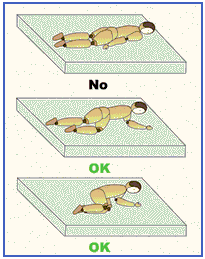
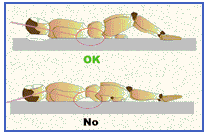

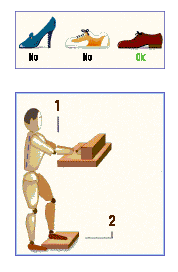
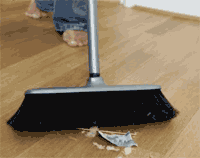
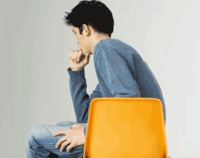
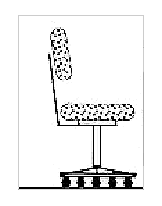
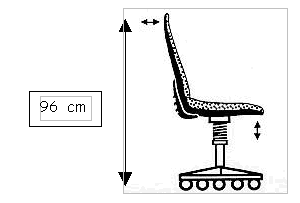
To prevent back pain, it is recommended to do exercise or to be at least physically active, avoiding a sedentary lifestyle, and to maintain a courageous mental attitude to pain and meet standards of postural hygiene.
The good posture is that in which a series of mechanical standards are fulfilled ideals that ensure the distribution of the body's weight in a homogenous way and that provides the effort of the muscles to maintain it or carry out some stock.
A bad bodily posture is fundamental in the appearance of the backache, as well as of pains and nuisances of joints of the limbs, and it can trigger for various reasons. The more usual ones tend to be extended periods of an activity in a static posture, muscle fatigue, an injury that causes pain, respiratory or abdominal pathological processes, a long period of inactivity or immobilisation, etc.
Environmental elements also influence in the adoption of inadequate postures when they are ill-situated and oblige correct biomechanical conditions to be forced or modified.
The psychosocial environment where an activity takes place also influences in the adoption of incorrect postures. There is an interrelation between the posture and mental state of the individual, stress and the perception of pain and fatigue.
The postural hygiene consists of to learn to adopt postures and to carry out movements or efforts of the everyday life of the way more suitable in order to to decrease the risk of suffering backache. Similarly, for those who already suffer back pain, knowing how to carry out the day-to-day efforts can improve its autonomy and the limitation of its activity. In both cases, so that it is efficient, it is necessary that the patient learns how to protect their back when adopting postures or carrying out efforts, remember postural measures and apply them systematically in their daily life.
As basic principles to prevent back pain, it is necessary to consider the following recommendations:
Keep your back straight:
It is very important to keep the spine straight so that the intervertebral discs can distribute the weight correctly. It is essential to make an effort to keep the trunk straight, which means persevering to overcome the tendency to bend and follow the impulse to give in to the weight. It is necessary to correct this tendency, but without overdoing it. Being straight means holding the back straight in a natural way, without forcing it. Maintaining a rigid, forced posture causes the back muscles to get tired.
The position of a straight back is achieved by:
- Throwing shoulders back gently
- Keeping the head raised with a straight neck
- Gently holding the stomach in
Bending the knees:
Another point that needs to be taken into account is acquiring good habits when bending. It is necessary to bend the knees and not the back when picking up an object from the ground, lifting a weight, etc.
Postural hygiene standards
Sleeping:
Sleeping face downward is not really advisable, as it can modify the curvature of the lower back and the head has to be tilted for several hours. Neither is it advisable to sleep face up with the legs outstretched, as this causes the back to arch leaving a gap under the kidneys. The recommended position is face up but with a small pillow under the knees so that the legs are slightly bent and the arch of the back is reduced; if you asleep sideways, you should bend your legs.
The mattress must be firm and straight, and adapt to the curvatures of the spine. Very hard mattresses are just as harmful as very soft ones.
It is recommended that the pillow is rather thin to avoid excessive flexion of the cervical spine if you sleep face up; if you sleep sideways, you should use a thicker pillow or else a thin pillow rolled up so that the head is straight in line with the spine.
Carrying weight:
When carrying weight, avoid arching the spine forward with straight legs. It is recommended to find positions of equilibrium, so that the centres of gravity of the load and the body are as close as possible.
It is important to take into account that when we lift loads, we should do so only up to chest level with the elbows bent. If we need to place the load higher than chest level, we should use a stool or a ladder.
Static posture:
When standing, raise one foot and rest it on a stool or footrest; alternate the two feet and change the posture as often as possible. The spine suffers more when we stand in a static position, so it is a good idea to move around. If you have to work with your arms while standing, do so at a height that allows you to support your arms and avoid being constantly bent or bending your back.
Avoid wearing high heels if you have to stand or walk a lot. Completely flat footwear or shoes without a heel are not the most recommended either, especially if you have knee problems. The most suitable heel is between the 1,5 and 3 centimetres.
Housework
Sweeping and mopping the floor:
Ensure that the sweeping brush or the mop is long enough to reach the floor so that you do not have to bend over. If this is not the case, replace the brush or the mop, because it will be impossible to use it without overloading your spine. Your hands should be able to hold the brush or the mop between your chest and hips. Sweep or mop as close to your feet as possible, only moving your arms and not your waist, makng sure that your spine is constantly vertical and not bent.
Cleaning windows:
When cleaning with the right hand, put your right foot forward and your left leg back, and support your left hand on the window frame at shoulder height. After a while in this position, reverse your posture and use your left hand to clean the window. The arm used for cleaning should be belt at the elbow. Begin to clean at chest level to eye level. To clean over this height, use a ladder and use one hand for support. Make sure your spine is straight and distribute your weight between your feet and the hand used for support.
Ironing:
The ironing board should reach your navel or slightly above it. Keep one foot raised on a footrest and alternate both feet. If at some point you have to apply pressure on the ironing surface, take your foot off the footrest and support your free hand on the ironing board. This way, your weight will be distributed between the hand used for support and your two feet, and not your spine. In this posture, use your arm and not your weight to apply pressure with the iron against the ironing board.
In the kitchen:
Kitchenware should be positioned in the cupboards so that the heavier objects are between hip and chest level. If you have to get something out of a low shelf or cupboard, bend down with your feet slightly apart and keep your back straight. If the shelf is high up, use a stool.
Doing the shopping:
It is better to use a shopping trolley with the load in front of you, as pulling the load behind you forces you to twist abruptly. It is better to push than to pull. If you are carrying bags, make sure to distribute the weight equally between the two arms. It is better to take two small bags than one large one.
Children at home
Taking a baby out of the cot: pick up the baby according to the standards for lifting loads. Stand at one corner of the cot (e.g. the left corner) with the right foot behind the left one. Bend your knees, lift up the baby and stretch your legs to stand up again.
Bathing a child:
To lift the child into or out of the bath, stand beside the bath holding the child at chest level. Place one foot behind the other and bend the back leg so that your knee is supported on the floor; then place your elbows on the side of the bathtub. Hold the child with one arm and put your other arm on the opposite side of the bath. Lower the child into the bath slowly. To take the child, repeat the above in reverse.
Teaching a baby how to walk:
Never help the baby to walk holding them by their arms stretched over their head, as this means that they are tilted in unstable equilibrium, and it is also damaging and uncomfortable for the baby's spine. If you want to help them to walk, go in front of the baby with your legs slightly apart, move one foot behind the other and gently bend your knees so that your elbows are resting on your legs. With this posture, take the baby's hands guiding him or her to walk forwards while you walk backwards with your knees bent. The leg muscles will probably get tired more quickly due to the effort, but it is better for the spine.
Sitting down
Chair height:
Your two feet have to be placed firmly on the ground with the knees at the same level or slightly above the hips. Footrests should only be used when, sitting correctly, both feet do not touch the ground. If you use a footrest, it should have an adjustable angle between 0º and 15º in the horizontal plane.
Chair backrest:
The chair backrest should have a slight protusion and the chair should support the back in the same posture that the spine is in when in a standing position, i.e. respecting physiological curvatures. There are two types of backrests on the market:
Removable backrest for chair:
This should be height and angle adjustable so that the lumbar vertebrae can be supported correctly.
Fixed backrest for chair:
It should provide lumbar support and be angle adjustable. These backrests provide total support and that is why it allows the muscles to relax and fatigue to be reduced.
Getting out of a chair:
When getting out of a chair, support your hands on the armrests. If the chair has no armrests, place your hands on your thighs and knees and always keep your back straight or slightly tilted backwards while standing up.
Sitting down on a chair:
Sit down purposefully. Do not collapse onto the chair. When sitting down, keep your back straight and as far back as possible in the chair¡. Your arms and legs should form 90º angles.
Driving the car:
When getting into the car, sit inside first with your feet outside of the car, and then introduce them into the car first one and then the other, turning your body at the same time and supporting your weight with your hands. Move the seat forward so that it is not necessary to stretch your legs to reach the pedals and use the backrest for your backAdvance the seat to arrive at pedals without having to stretch legs and supports the back against the backup.
6. Back and pregnancy
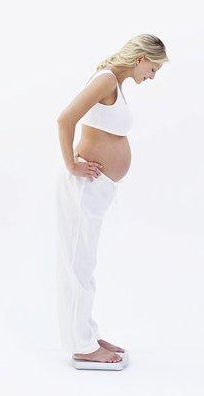
Lower back pain or sciatica often occurs during pregnancy.
The principal factors responsible for the pain in these cases are the relaxation of the abdominal muscles and increased lumbar lordosis. This is due to the weight of the foetus which is especially noticeable during the final months of pregnancy, when the centre of gravity of the body changes and the spine is arched slightly backwards; due to these changes, the muscles and tendons in the back are subjected to because of these changes muscles and tendons of the back are subjected to overloading and the paravertebral muscles contract.
In the vast majority of cases, the pain arises from the contraction of the back muscles. Only rarely is the pain caused by an organic disorder of the spine.
A sedentary lifestyle and rest are in themselves risk factors for back pain and it lasts longer; this is because they contribute quite quickly to a loss of strength and muscle mass, which increases the llikelihood of overloading and injuring the muscles.
Sometimes the rise in volume of the uterus and the pelvis can lead to the compression of a nerve root and cause sciatica (radiating pain down the leg).
To prevent back pain in pregnancy:
- Avoid rest unless required for medical reasons (risk of miscarriage, early delivery, etc.).
- Comply with postural hygiene.
- Do a certain amount of physical activity, as long as it is not contraindicated.
When a pregnant woman is standing up, she tends to arch the lower back excessively and push the belly forward. To compensate, she throws her shoulders back and puts her hands on her kidneys, emphasising the curvature even more.
7. Exercises to strengthen and stretch back muscles

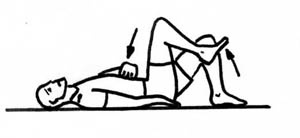
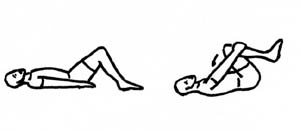
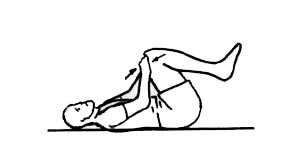
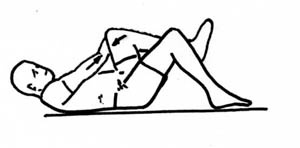

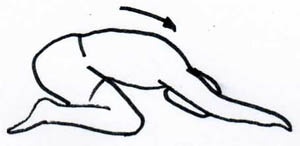
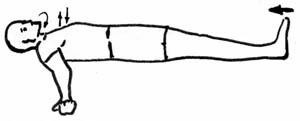
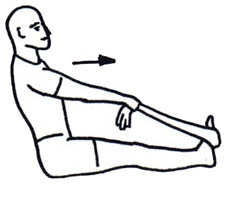
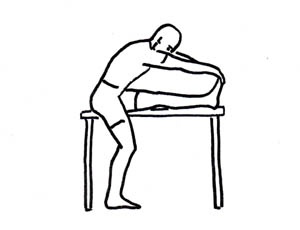
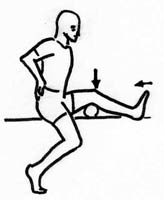
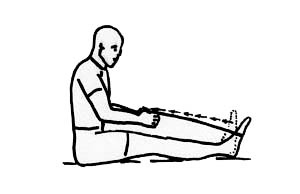
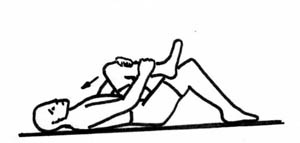
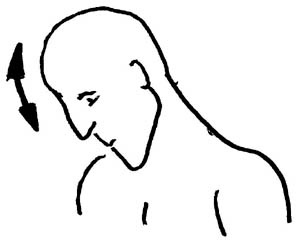
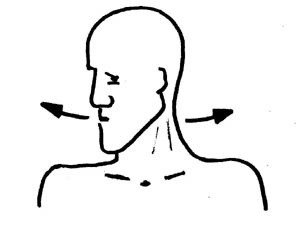
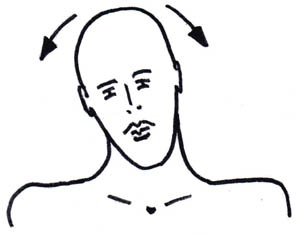
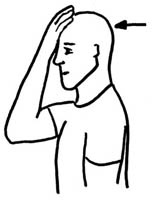
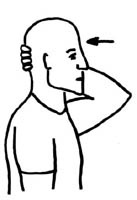
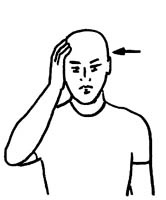
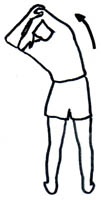
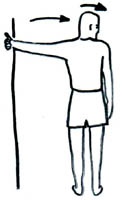
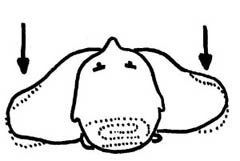
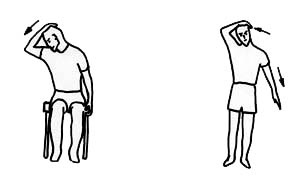
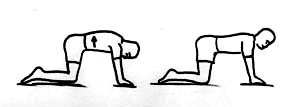
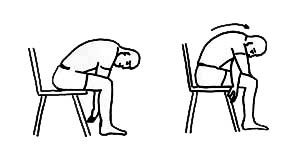
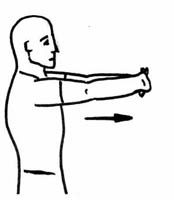
The aim of exercise is to develop the muscles involved in the operation of the spine (back, abdominal and gluteal muscles) and to improve its coordination.
Strong, balanced and well-coordinated muscles improve the stability and the operation of the spine, decreases the risk of injury of the intervertebral disk and facilitates movement. In addition, it improves the unconscious coordination of the muscles, which is why it decreases the risk of muscle and ligament overload or injury.
In fact, the following factors influence the risk of back pain or repeated back pain:
-
The generalphysical form: sedentary people who are in poor physical condition have a higher risk of suffering back pain than those who practice regular physical activity.
-
The state of the back'smusculature: pain is more frequent and prolonged in people that have weak back and abdominal muscles.
-
The mild aerobic physical activity assistance to recover the muscular tone and the coordination of the different muscular groups, especially if the patient has had to do repose previously. At first, it is enough to go walking and swimming, and later the intensity of the exercise can be increased.
Secondly, when the episode of acute pain has passed, the patient can begin a specific physical exercise proramme, customised according to the characteristics of each patient.
Physical exercise is useless or it can even be counterproductive when the same exercises are prescribed in all cases. It is fundamental to personalise training exercises and guidelines for every patient according to factors as, for example, its muscular state previous, characteristics of the backbone or the afección that it suffers.
Rest
The aim of rest is to give the cause of the pain time to cure itself, as some injuries improve by reducing the inflammation and the overload. However, bed rest is not effective for treating back pain.
Available research indicates that bed rest, especially if it is for more than four days, results in a loss of strength and increases the difficulty to rehabilitate the patient.
The mechanical philosophy of the human body can be summed up one phrase:
to prevent injuries, the front of the body (the abdominal muscles) must have good muscle tone and the back needs good resilience.
Exercises for the spine
Exercises for stretching muscles
Exercises for strengthening the lower back muscles. Exercise 1
- Base position: the patient in supine position with legs bent.
- Take in air by inflating the abdomen.
- Release the air and sink the abdomen feeling how the lower back is levelled against the floor at the same time that the hips are pushed upward.
- Hold the position for a few seconds and return to the starting position.
- Repeat ten times twice.
Exercises for strengthening the lower back muscles. Exercise 2
- The patient in supine position with legs bent and pelvis tilted.
- Take in air by inflating the abdomen.
- Release the air while bringing the knee to the chest. Hold the pain while expelling all the air.
- Lower the leg while taking in air again.
- Repeat with the other leg.
- Repeat ten times twice.
Exercises for strengthening the lower back muscles. Exercise 3
- It is done in the same way as the previous exercise but with the two legs at the same time.
Strengthening the lower back muscles. Exercise 4
- In the supine position, bend the legs and raise them towards the chest.
- Take a deep breath.
- Push with your two hands on your legs at the same time.
- Release the air slowly and notice how the stomach muscles contract.
Strengthening the lower back muscles. Exercise 5
- The patient in supine position with legs bent.
- Take in air by inflating the abdomen.
- Put pressure on the left knee with the right hand while releasing the air slowly.
- Hold the contraction for five seconds.
- Repeat with the other leg.
- Repeat ten times twice.
Strengthening the lower back muscles. Exercise 6
- The patient in supine position with legs bent.
- Put your hands under your head.
- Take in air by inflating the abdomen.
- Find a fixed point in the ceiling; keep looking at it and, without forcing the cervical muscles, raise your head and shoulders.
- Hold the contraction for five seconds.
- Repeat ten times twice.
Lower back stretches
Lower back stretches. Exercise 1
- Position: kneeling on the floor, the hips just behind the knees.
- The hip steady and the abdominal muscles held in.
- Arms stretched with hands placed on the floor.
- Take a deep breath.
- While we release the air, try to stretch the whole spine imagining pushing the buttocks backward and the head forward (as if we were pulling it).
Lower back stretches. Exercise 2
- In supine position with knees stretched.
- Dorsiflexion of the ankles (feet facing upward toward the head) and chin facing downward (double chin).
- Breathe in inflating the highest part of the chest.
- Exhale lowering the thoracic or rib cage and trying to increase the dorsiflexion of the ankles and the double chin.
Lower back stretches. Exercise 3
- Sit down on a firm surface.
- Put a towel around the sole of the foot of the leg that you are going to stretch.
- Keep the lower end of the back straight.
- Gradually, pull the towel towards you until you notice a pulling in the back of the thigh.
Lower back stretches. Exercise 4
- Stand on a firm surface with one leg outstretched in front of you.
- Slowly bend down trying to touch your toes with your hand.
Lower back stretches. Exercise 5
- Get into the same position as in the previous exercise, but with a towel under your knee.
- Press your knee against the towel at the same time that you bend your foot towards the head.
Lower back stretches. Exercise 6
- Sit down on a firm surface.
- Put a towel around the sole of the foot of the leg that you are going to stretch.
- Keep the lower end of the back straight.
- Gradually, pull the towel towards you until you notice a pulling in the back of the thigh.
Lower back stretches. Exercise 7.
- In supine position.
- Bend your leg to a 90º angle and hold it with one hand on the knee and the other on top of your foot.
- Bring the leg towards your body while turning it at the same time until you notice a pull in the most internal area of the gluteus.
- This exercise can also be done sitting down.
Exercises of the cervical spine
Exercises for stretching muscles
Exercises to strengthen the cervical muscles. Exercise 1.
- Slowly bend your head forwards until you notice a pull in the back part.
- Hold the flexion for three seconds.
- Do ten repetitions twice.
Exercises to strengthen the cervical muscles. Exercise 2.
- With your back straight and without moving your shoulders, turn your head to one side and then to the other (saying no with the head).
- Hold your head to each side for three seconds.
- Do ten repetitions twice.
Exercises to strengthen the cervical muscles. Exercise 3.
- Looking in front of you, move your head slowly to one side and then to the other.
- Hold your head to each side for three seconds.
- Do ten repetitions twice.
Exercises to strengthen the cervical muscles. Exercise 4.
- Place the palm of your hand on your forehead.
- Push your forehead against your hand while bending your head forward.
- Do ten exercises once each once a day.
- Hold the pressure for twelve seconds.
- Rest for ten seconds between exercises.
Exercises to strengthen the cervical muscles. Exercise 5.
- Place the palm of your hand behind your head.
- Use your head to put pressure on your hand without bending the nape of your neck.
- Do ten exercises once each once a day.
- Hold the pressure for twelve seconds.
- Rest for ten seconds between exercises.
Exercises to strengthen the cervical muscles. Exercise 6.
- Place the palm of your right hand on the right-hand side of your head.
- Use your head to put pressure on your hand by tilting your head to the side.
- Repeat on the left side.
- Do ten exercises once each once a day.
- Hold the pressure for twelve seconds.
- Rest for ten seconds between exercises.
Cervical stretches
Cervical stretches. Exercise 1
- Standing with your knees semi bent for better balance, lift your right arm and place it over or behind the head.
- Tilt your body to the left.
- Repeat with the other arm.
Cervical stretches. Exercise 2
- Lean on the wall with your hand backwards.
- Gradually, turn your body outwards until you notice a pull in your chest.
Cervical stretches. Exercise 3
- Lying down on your back, put a towel between your shoulder blades.
- With your arms down by your sides, gently move your shoulders towards the floor.
- Hold the stretches for between seven and ten seconds.
Cervical stretches. Exercise 4
- Gently stretch your arm downwards and your head in the opposite direction with the help of your other hand.
- Hold the stretch for seven seconds and change side.
- Place your hand on your head and pull down diagonally gently on it towards your chest on the same side.
- Hold the stretch for seven seconds and change side.
Upper back exercises
Exercises for stretching muscles
Exercises to strengthen the upper back muscles. Exercise 1
- Get down on all fours.
- Take in air in this position and, while you breathe out, put your head between your arms arching your entire spine upwards.
- Return to the starting position while breathing in.
- Again, release the air and relax the entire spine in the opposite direction to before until you are back in the starting position.
- It is important that you do not force the lumbar arch so that the spine does not suffer.
Upper back stretches
Exercises to stretch the upper back muscles. Exercise 1
- Sitting in a chair with the spine relaxed.
- Lower your trunk with the help of your elbows, relaxing your spine as much as possible.
- Hold the position for between fifteen and twenty seconds.
- Go back to the initial position using your elbows and hands to help you.
Exercises to stretch the upper back muscles. Exercise 2
- Intertwine the fingers of both hands.
- Stretch your arms so that the palms of your hands are facing outward.
- Stretch your hands forward.
- Hold the stretch for between seven and ten seconds and relax.
